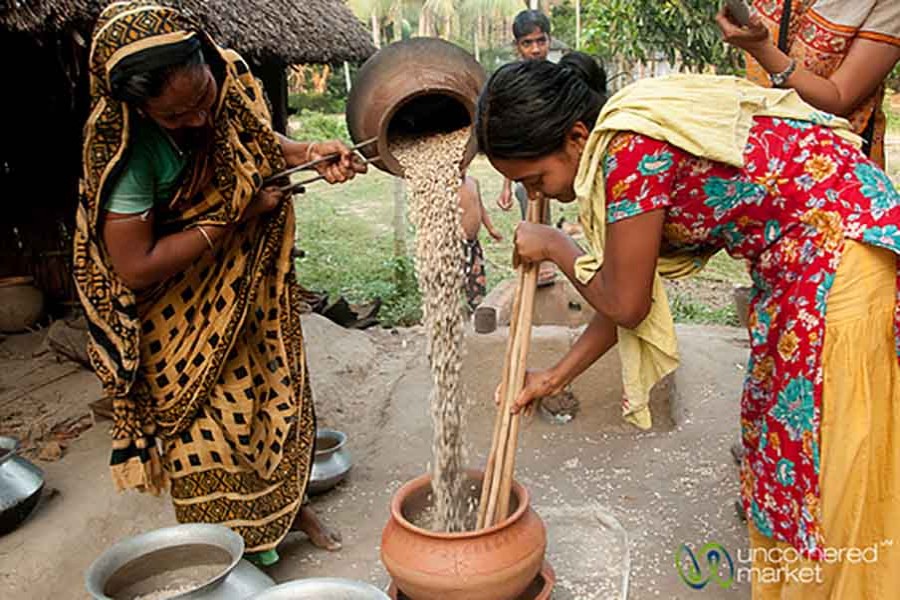We define a worker or labourer as a person who is engaged at least for one hour in activities that fetch, increase or save income for the household. This definition includes both full-time and part-time labourers whereas in discussion on occupational status, we generally deal with only full-time workers. Under this new definition, the number of working members per household in rural areas has declined from 2.65 to 2.59 over time. But while male working members showed a downward turn, female working members depicted a marginal rise. The reasons for the decline in the number of workers include, inter alia, a reduction in household size from decline in fertility, migration of working members to cities and abroad, and increase in school participation in secondary and tertiary levels.
It also appears that over time, the duration of economic labour performed by an average worker has been reduced substantially from about four-fifths to three-fourths. This happened due to a reduction in labour force participation by men with the share of women remaining almost the same. Two factors could be adduced to this trend: first, men have growingly been attracted to domestic activities, and hence their relative contribution to economic activities has gone down. Second, the subsistence pressure of the households in the past forced young and old labour force to engage in economic activities and for those in active age groups to put in longer hours to earn a subsistence wage. In recent years, the subsistence pressure has eased somewhat with improvements in poverty situation and hence with economic solvency, poverty-induced longer work hours have been reduced. The old takes retirement if they can afford, and the young goes to schools abandoning child labour.
It is interesting to note that the duration of work effort has declined for both male and female labour force - from 9 hours/day to 8.5 hours/day in recent periods. The change is remarkable in the case of women workers as they put in 8.35 hours now compared to 9.20 hours in the eighties. That means, in the past, women used to work for more hours (in domestic and economic activities together) than men; now men work more than women. The 'magical' change in the duration of labour for women deserves an explanation. First, the reduction in fertility rate has saved for women time for involvement in childcare. Second, from some hard but cost-effective engagements - for example in boiling paddy, paddy husking through 'dheki' and other manual works - women have reduced the level of engagement as new technologies have entered the market. Now mobile threshers are at the doorstep to substitute women's' efforts for milling rice early in the morning with 'dheki'. Rice mills for parboiling of paddy and processing of rice are easily accessible. The house floors are paved, and hence women do not have to spend too much time for clearing dusts.
As is well-known, a part of the labour force in the age groups of 16-25, 60 and above, have shifted away from economic activities. But participation in economic activities as well as duration of work for 41-59 age groups has increased over time. What could be the reasons for this pattern? First, participation in schools and colleges of 16-25 age groups increased, thereby reducing participation of young adults in economic activities. Second, men aged 60 and above, particularly from economically better-off households, might have gone for retirement in the wake of improvements in economic conditions. Third, improved health conditions and increased life expectancy might have kept 41-59 age groups in works at an increasing rate. And finally, substitution effect and growing involvement in household works have possibly pushed down the participation rate in economic activities for workers in the 26-40 age groups.
A more useful insight into the issue of labour force participation can be derived when work effort is related to the educational status of the worker. First, the number of working members has increased for all groups in the scale of educational status, excepting the group that did not have formal schooling (illiterate). This implies that illiterate households have relatively high dependency ratio. Second, the participation in economic activities has increased for workers attending or passing secondary level, but decreased for the groups with lower educational levels (illiterate or those attending only primary schools). For relatively better educated workers, the duration of work has increased over time. The educated men (of secondary level of education) are increasingly giving more time to domestic activities that were previously done by paid domestic helpers, especially by women. We can, perhaps, mark this trend as a new dimension in the arena of our social development. The data also shows evidence of the backward bending supply curve of labour.
The following points are noted from the analysis of nature of work and gender roles in labour use: (a) participation as well as duration in economic activities has increased for women, while that of men has decreased over time; (b) pervasive exit of men from agriculture and a leaning towards non-agricultural activities are in evidence over time; (c) participation of women in agricultural labour market decreased, perhaps, due to a decline in subsistence pressure; (d) both in terms of the proportion of the labour force and duration of work, increasing attraction of non-agricultural activities pushed back agricultural engagements and (e) the role of agriculture in employment generation of men diminished substantially, while the decline was marginal in the case of women. This finding carries important implication in the formulation of agricultural policies, especially in employment generation of women. For women, the market seems to be losing its importance as a source of employment in agriculture. In the case of non-agricultural activities, the role of the market remains more or less for men but that role has substantially been reduced for women. The pattern so posited reminds us that, in rural areas, possibly self-employment has gained in importance over time.
The writer is a former Professor of Economics at Jahangirnagar University.


